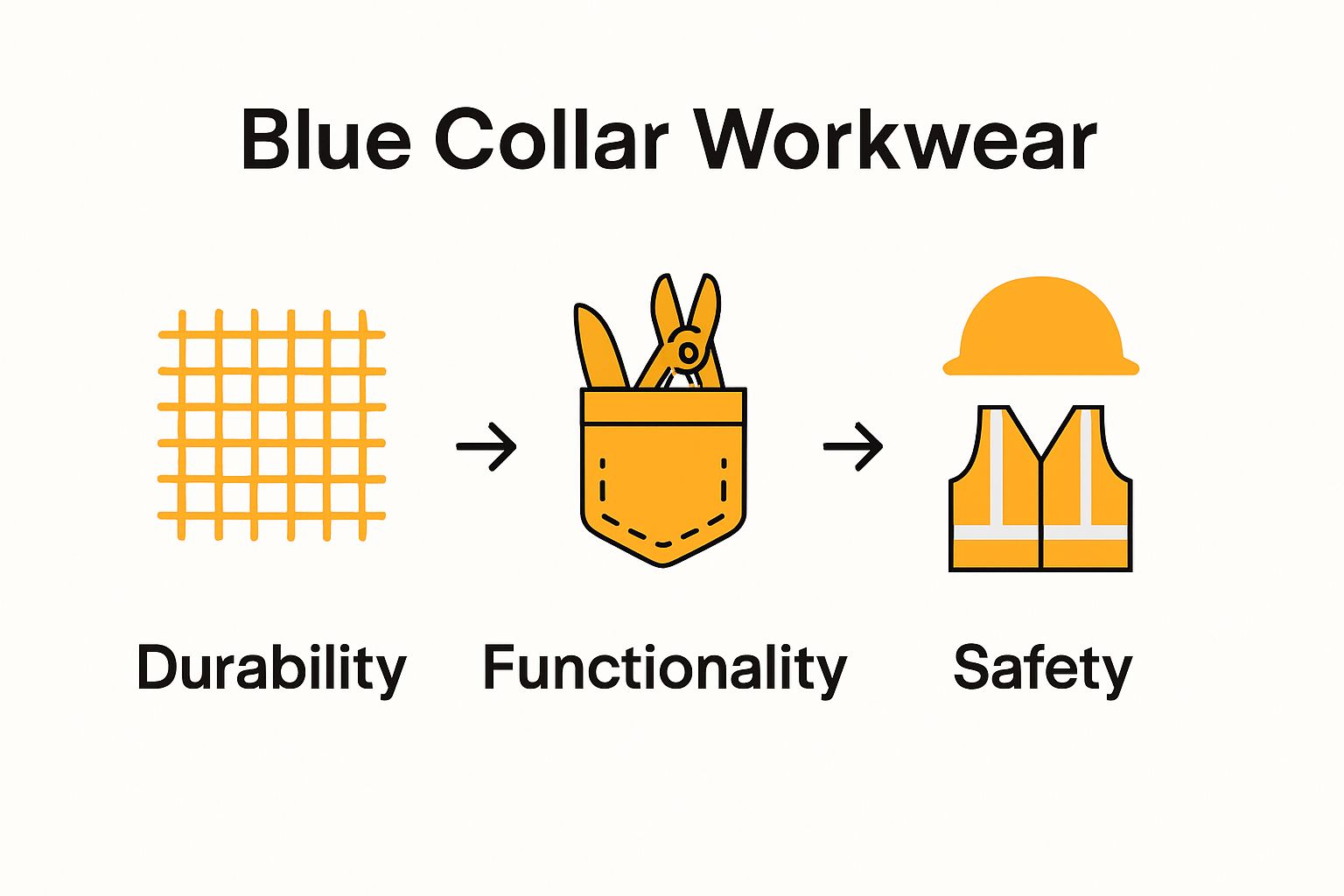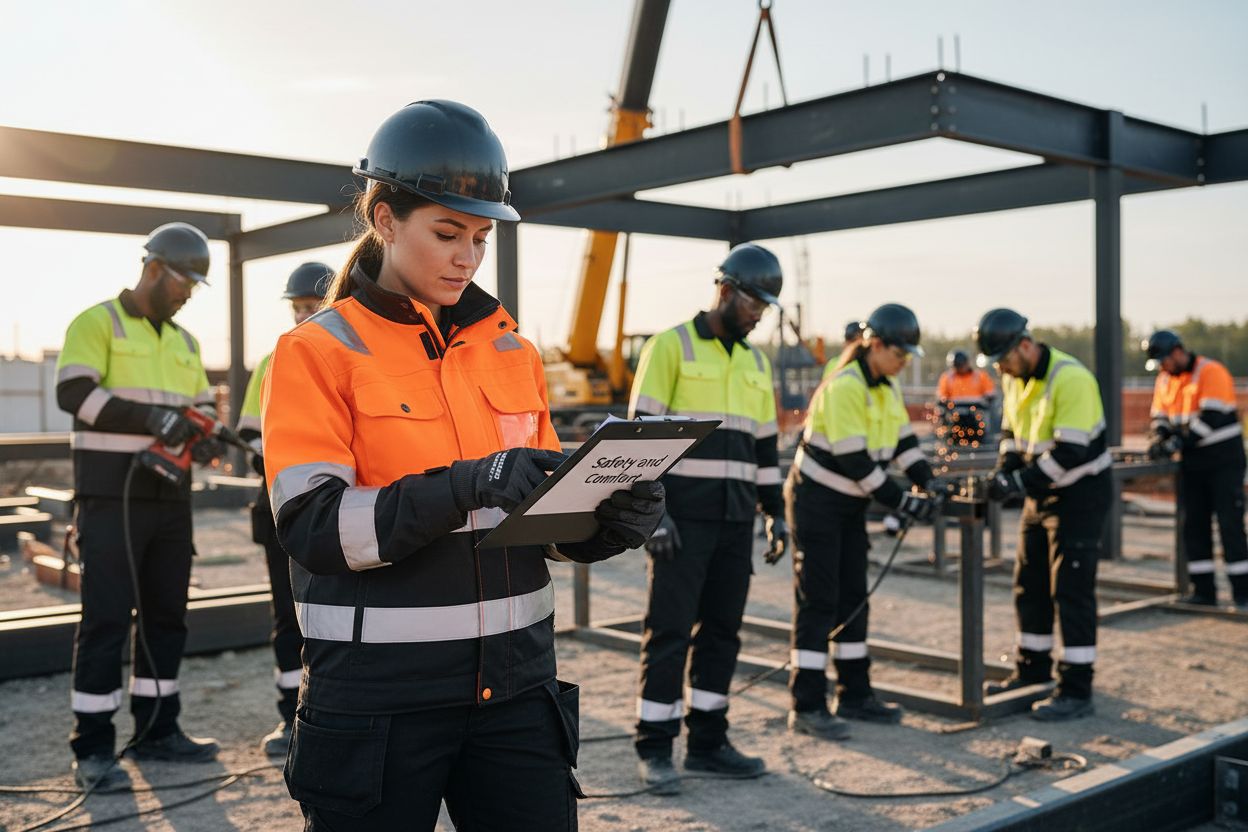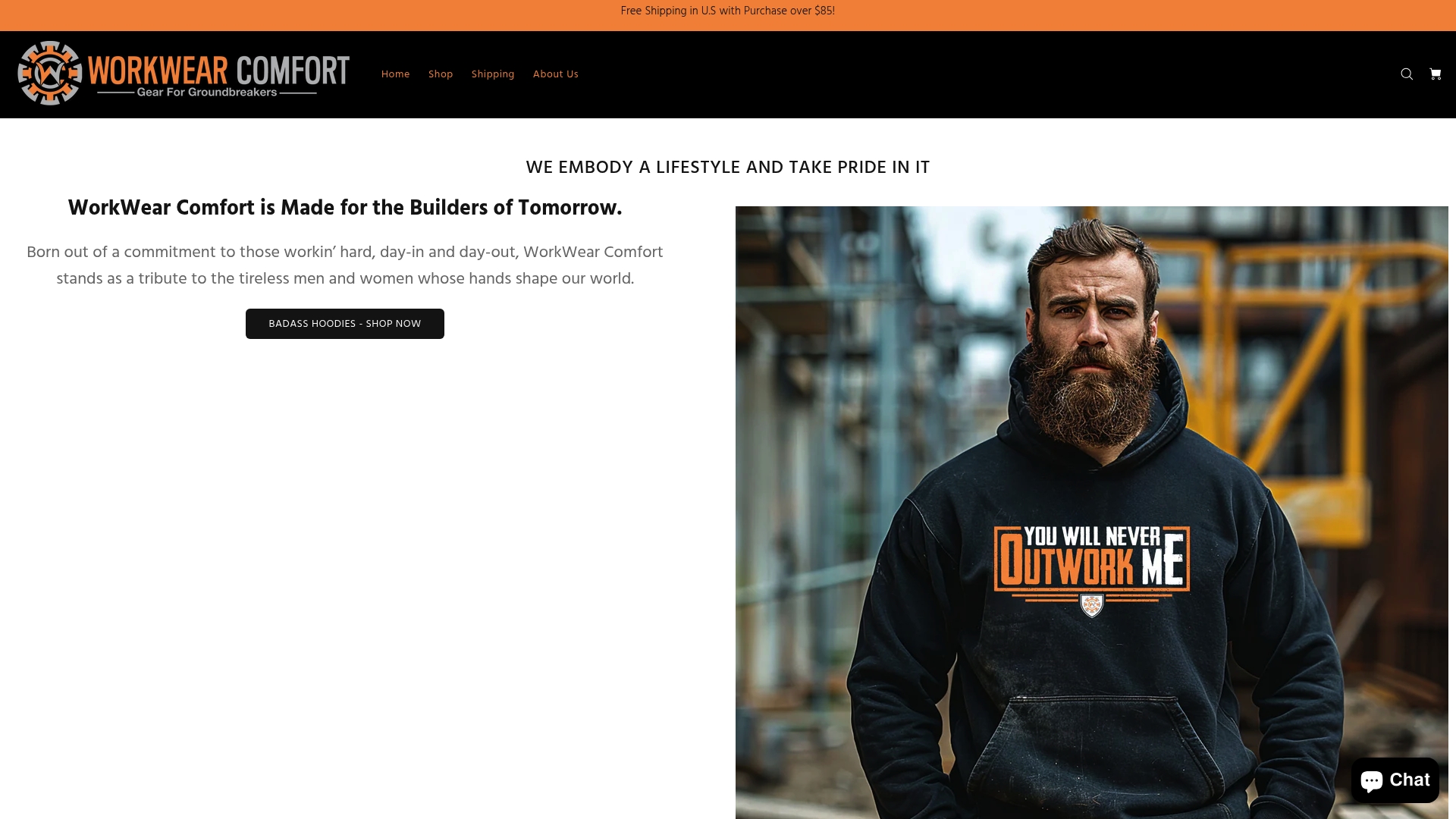The blue collar dress code does a lot more than cover workers on the job. It is an identity and safety system rolled into every shirt, pant, and boot. Even more surprising, over 80 percent of workplace injuries can be prevented through proper protective workwear. Most people think of uniforms as simple rules or looks, but blue collar clothing is actually custom-built armor designed for the toughest environments. This is where function, safety, and personal pride come together in every seam.
Table of Contents
- What Is The Blue Collar Dress Code?
- The Importance Of The Blue Collar Dress Code In The Workplace
- Key Features Of Blue Collar Workwear
- Navigating Safety And Comfort In Blue Collar Attire
- The Future Of Blue Collar Dress Code Trends
Quick Summary
| Takeaway | Explanation |
|---|---|
| Safety is the top priority | The blue collar dress code emphasizes protective clothing to combat workplace hazards effectively. |
| Durability is essential | Clothing must withstand harsh environments and physical strain to enhance worker performance. |
| Functional design boosts efficiency | Workwear features ergonomic elements for mobility and utility, improving overall productivity. |
| Professional identity is communicated through attire | Well-designed workwear signals expertise and commitment, fostering respect among colleagues. |
| Emerging trends focus on sustainability and technology | Future workwear innovations include eco-friendly materials and smart fabric technologies for better performance. |
What is the Blue Collar Dress Code?
The blue collar dress code represents more than just clothing choices for workers in physically demanding and trade-based professions. It is a practical uniform that combines functionality, durability, and professional identity. These clothing standards evolved from industrial and manufacturing workplace requirements, designed to protect workers while providing comfort during intense physical labor.
Core Principles of Blue Collar Attire
Blue collar dress code fundamentally prioritizes safety, mobility, and resilience. Unlike white-collar professional attire, these clothing standards are engineered to withstand harsh environmental conditions, potential workplace hazards, and repetitive physical movements. Learn more about blue collar worker definitions to understand the context behind these clothing choices.
Key characteristics of blue collar dress code include:
- Durability as the primary design consideration
- Emphasis on protective materials and construction
- Functionality over aesthetic appearance
- Resistance to wear, tear, and workplace contaminants
Practical Considerations and Cultural Significance
The blue collar dress code transcends mere clothing selection. It represents a professional identity deeply rooted in manual labor, craftsmanship, and practical skills. Workers in construction, manufacturing, agriculture, and trades rely on clothing that can endure challenging work environments while maintaining professional standards.
Typical blue collar dress code elements include robust work pants with reinforced knees, heavyweight shirts or jackets with multiple utility pockets, steel-toed boots, and protective accessories like hard hats or safety glasses. These clothing choices are not just about appearance but serve critical functional purposes in preventing workplace injuries and enhancing worker efficiency.
Understanding the blue collar dress code means recognizing it as a comprehensive system of workplace attire that balances protection, comfort, and professional representation for workers across various industries.
The Importance of the Blue Collar Dress Code in the Workplace
The blue collar dress code is far more than a simple set of clothing guidelines. It serves as a critical mechanism for workplace safety, professional identity, and organizational efficiency across various industries. Discover more about durable work clothing strategies to understand its comprehensive significance.
Safety and Protection
At its core, the blue collar dress code prioritizes worker safety through strategic clothing choices. Professional attire in trade and manual labor industries acts as a first line of defense against potential workplace hazards. Work clothing must protect against environmental risks, chemical exposures, mechanical injuries, and extreme temperature conditions.
Key safety considerations include:
- Impact and abrasion resistance
- Chemical and flame retardant properties
- Visibility in low-light or high-risk environments
- Temperature regulation and thermal protection
Professional Identity and Performance
Beyond physical protection, the blue collar dress code communicates profound professional values. These clothing standards represent expertise, commitment, and skill within trade professions. Well-designed workwear signals to colleagues, supervisors, and clients that a worker is serious, prepared, and technically competent.
Moreover, appropriate workplace attire directly influences worker performance. Clothing that allows unrestricted movement, provides necessary tool storage, and maintains comfort enables workers to perform tasks more efficiently and with greater confidence.
Cultural and Psychological Implications
The blue collar dress code extends beyond mere utility. It embodies a cultural narrative of hard work, craftsmanship, and professional pride. Workers wearing standardized, functional clothing create a sense of collective identity and mutual respect within their professional communities.
Psychologically, appropriate workwear can boost worker morale, create a sense of belonging, and reinforce professional standards. When workers feel properly equipped and represented by their clothing, they demonstrate increased job satisfaction and commitment to their roles and organizations.
This table summarizes the impact of blue collar attire on safety, performance, and psychological well-being in the workplace.
| Aspect | Contribution to Workplace |
|---|---|
| Safety | Protects against mechanical, chemical, and environmental hazards |
| Performance | Enables greater efficiency, mobility, and tool accessibility |
| Professional Identity | Signals expertise, commitment, and technical competence |
| Morale & Belonging | Fosters collective identity and job satisfaction |
Key Features of Blue Collar Workwear
Blue collar workwear represents a sophisticated engineering of clothing designed specifically for demanding physical environments. These garments transcend traditional fashion, functioning as critical tools that enhance worker safety, efficiency, and professional performance. Learn more about blue collar work dynamics to understand the comprehensive requirements behind these specialized clothing choices.
Durability and Material Construction
At the heart of blue collar workwear lies an unwavering commitment to durability. Clothing materials are meticulously selected to withstand extreme conditions, repetitive movements, and potential workplace hazards. Advanced textile technologies enable the creation of work garments that can endure intense physical strain while maintaining structural integrity.

Key material considerations include:
- High-tensile strength fabrics
- Reinforced stress points and seams
- Resistance to tears, abrasions, and punctures
- Synthetic blends with enhanced durability characteristics
Functional Design and Ergonomic Features
Blue collar workwear goes beyond basic protection, incorporating intelligent design elements that directly support worker productivity. Ergonomic features are strategically integrated to facilitate movement, provide tool accessibility, and reduce physical strain during complex tasks.
Critical functional design elements typically include:
- Multiple strategically placed utility pockets
- Articulated knees and expanded range of motion
- Integrated tool loops and attachment points
- Adjustable closures for personalized fit
Safety and Performance Enhancement
Modern blue collar workwear serves as a comprehensive safety system. Advanced clothing technologies incorporate protective elements like high-visibility materials, flame-resistant fabrics, and environmental adaptability features. These clothing choices are engineered to mitigate workplace risks while supporting optimal worker performance.
The evolution of blue collar workwear reflects a profound understanding of worker needs, transforming clothing from a mere protective layer into a sophisticated performance enhancement tool.
Below is a table highlighting the core features of blue collar workwear, helping you quickly compare key attributes for practical understanding.
| Feature | Description |
|---|---|
| Durability | Constructed with high-tensile strength fabrics and reinforced seams for longevity |
| Protective Materials | Engineered for resistance to tears, abrasions, punctures, and workplace contaminants |
| Functional Design | Includes utility pockets, tool loops, and ergonomic elements for ease of work |
| Safety Enhancements | Offers high-visibility materials and flame/chemical resistance to mitigate hazards |
| Comfort & Mobility | Integrates flexible, breathable fabrics with articulated knees for better movement |
| Temperature Regulation | Utilizes moisture-wicking and ventilated constructions for comfort in extreme conditions |
| By prioritizing durability, functionality, and safety, these garments represent a critical investment in worker well-being and professional effectiveness. |
Navigating Safety and Comfort in Blue Collar Attire
Blue collar attire represents a complex balance between personal protection, professional performance, and individual comfort. The intersection of safety requirements and workplace functionality demands a nuanced approach to clothing selection. Check out our guide on the best work pants to understand practical considerations in workwear design.
Safety Standards and Protective Features
Safety is paramount in blue collar workwear. Professional attire must meet rigorous industry standards that protect workers from potential hazards. According to OSHA guidelines, protective clothing serves as a critical barrier against workplace risks such as chemical exposures, mechanical injuries, and environmental challenges.
Key safety considerations include:
- Compliance with specific industry protective equipment regulations
- Materials that resist chemical and thermal exposures
- Integrated reflective elements for visibility
- Structural design that prevents potential entanglement hazards
Ergonomic Comfort and Performance
Beyond safety, blue collar attire must support worker mobility and sustained performance. Ergonomic design principles are crucial in creating workwear that allows unrestricted movement while maintaining protective capabilities. Clothing must adapt to dynamic work environments, enabling workers to perform complex tasks with maximum efficiency and minimal physical strain.
Essential comfort features encompass:
- Moisture-wicking fabric technologies
- Flexible materials with enhanced range of motion
- Breathable construction for temperature regulation
- Strategic ventilation zones
Psychological Impact of Workwear Design
Workwear design extends beyond physical protection, significantly influencing worker psychology and professional confidence. Well-designed attire communicates competence, signals professional preparedness, and contributes to a worker’s sense of identity and belonging within their professional community.
The strategic integration of safety features, comfort technologies, and professional aesthetics transforms blue collar attire from mere clothing into a sophisticated performance tool. By prioritizing worker well-being through intelligent design, modern workwear represents a critical investment in human capital and workplace effectiveness.

The Future of Blue Collar Dress Code Trends
Blue collar dress code is experiencing a transformative evolution, driven by technological advancements, sustainability concerns, and changing workplace dynamics. These emerging trends are redefining how workers approach professional attire, integrating cutting-edge innovations with practical functionality. Understand the evolving landscape of blue collar work to appreciate the comprehensive shifts in workplace clothing.
Technological Integration and Smart Fabrics
The future of blue collar workwear is deeply intertwined with technological innovation. Smart fabric technologies are revolutionizing traditional clothing concepts, introducing garments that can monitor worker health, adapt to environmental conditions, and provide enhanced protection. Advanced textiles now incorporate sensors that track physiological metrics, detect potential safety hazards, and communicate critical information in real-time.
Key technological advancements include:
- Embedded biometric monitoring systems
- Temperature-regulating materials
- Self-healing fabric technologies
- Integrated communication and GPS tracking capabilities
Sustainability and Environmental Consciousness
Environmental sustainability is becoming a critical consideration in blue collar dress code design. Manufacturers are shifting towards eco-friendly materials, circular production models, and clothing lifecycles that minimize environmental impact. Recycled synthetic materials, biodegradable fabrics, and production processes that reduce carbon footprint are transforming the workwear landscape.
Sustainability focus areas encompass:
- Recycled and regenerative textile materials
- Low-waste manufacturing processes
- Clothing designed for extended durability
- Modular designs enabling component replacement
Diversity and Inclusive Design
The future of blue collar dress code is increasingly recognizing diverse workforce needs. Workwear design is expanding beyond traditional standardized models, creating clothing that accommodates different body types, gender expressions, and individual workplace requirements. Adaptive clothing technologies are emerging that provide customizable fit, enhanced mobility, and personalized comfort across varied professional contexts.
This evolution represents more than a clothing trend. It signifies a profound reimagining of workplace attire as a dynamic, responsive system that prioritizes worker safety, comfort, technological integration, and environmental responsibility. By embracing these emerging trends, blue collar workwear is becoming a sophisticated tool for professional empowerment and workplace innovation.
Here is a comparison of emerging trends shaping the future of blue collar workwear, offering an at-a-glance view of changes in materials, technology, and inclusivity.
| Trend | Key Characteristics |
|---|---|
| Technological Integration | Smart fabrics, health monitoring, adaptive protection |
| Sustainability | Eco-friendly materials, recycled fabrics, low-waste production |
| Diversity & Inclusive Design | Adaptive fits for various body types, gender considerations |
Bring True Blue Collar Strength to Your Everyday Workwear
Are you searching for work clothes that actually live up to the demands of your job? This guide has shown that the real blue collar dress code means more than just clothing. It’s about protection, resilience, and representing your professional pride. Yet, finding gear that combines safety, durability, and the right attitude can be overwhelming. That’s exactly where Parody Blue Collar Hoodie Sweatshirts step in, offering you tough materials, practical features, and designs that celebrate the hard-working spirit described in this article.

Upgrade your workday by shopping directly at WorkwearComfort.com. Complete your look and stay comfortable and protected no matter where the job takes you. For a standout finishing touch that matches your blue collar pride, explore our Snapback and Dad Hats - Blue Collar Collection. Your next shift deserves clothing that works as hard as you do. Visit now to discover the gear your work ethic demands.
Frequently Asked Questions
What are the core principles of the blue collar dress code?
The blue collar dress code prioritizes safety, mobility, and durability. Focus on selecting clothing that withstands harsh environments, protects against workplace hazards, and allows for ease of movement during physical tasks.
How does the blue collar dress code contribute to workplace safety?
The blue collar dress code serves as a critical safety mechanism by providing protective clothing that guards against hazards like chemical exposure and mechanical injuries. Assess your work environment and choose attire that meets safety standards specific to your job.
What features should I look for in blue collar workwear?
When selecting blue collar workwear, look for durability, functional design, and safety features. Aim for materials that resist tears and abrasions, and include pockets for tool storage and ergonomic designs for comfort during extended wear.
How can blue collar attire impact worker performance?
Properly designed blue collar attire enhances worker performance by allowing unrestricted movement and providing necessary tools within reach. Ensure your clothing fits well and supports your work tasks for improved efficiency and confidence.
What emerging trends are shaping the blue collar dress code?
Emerging trends in the blue collar dress code include smart fabrics for health monitoring and sustainability through eco-friendly materials. Stay informed about these innovations to ensure your workwear meets both safety and environmental standards in the future.
Why is professional identity significant in the blue collar dress code?
Professional identity in the blue collar dress code reflects expertise and commitment within manual labor sectors. Wear well-designed work attire to communicate your professionalism and foster respect in your workplace environment.


